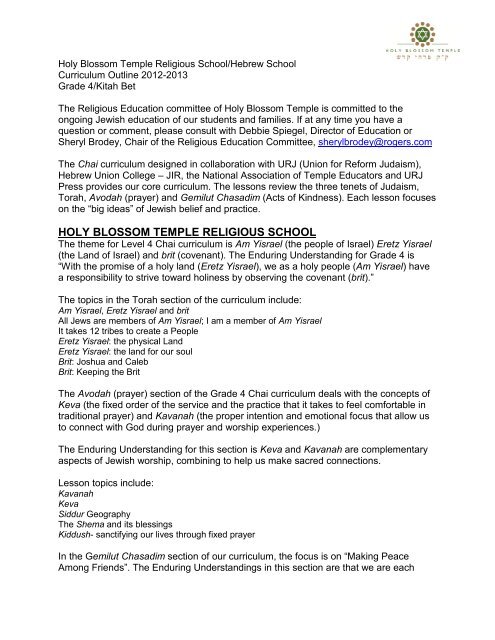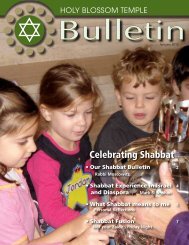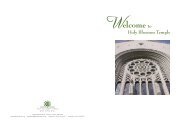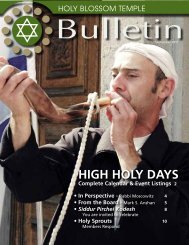HOLY BLOSSOM TEMPLE RELIGIOUS SCHOOL
HOLY BLOSSOM TEMPLE RELIGIOUS SCHOOL
HOLY BLOSSOM TEMPLE RELIGIOUS SCHOOL
Create successful ePaper yourself
Turn your PDF publications into a flip-book with our unique Google optimized e-Paper software.
Holy Blossom Temple Religious School/Hebrew School<br />
Curriculum Outline 2012-2013<br />
Grade 4/Kitah Bet<br />
The Religious Education committee of Holy Blossom Temple is committed to the<br />
ongoing Jewish education of our students and families. If at any time you have a<br />
question or comment, please consult with Debbie Spiegel, Director of Education or<br />
Sheryl Brodey, Chair of the Religious Education Committee, sherylbrodey@rogers.com<br />
The Chai curriculum designed in collaboration with URJ (Union for Reform Judaism),<br />
Hebrew Union College – JIR, the National Association of Temple Educators and URJ<br />
Press provides our core curriculum. The lessons review the three tenets of Judaism,<br />
Torah, Avodah (prayer) and Gemilut Chasadim (Acts of Kindness). Each lesson focuses<br />
on the “big ideas” of Jewish belief and practice.<br />
<strong>HOLY</strong> <strong>BLOSSOM</strong> <strong>TEMPLE</strong> <strong>RELIGIOUS</strong> <strong>SCHOOL</strong><br />
The theme for Level 4 Chai curriculum is Am Yisrael (the people of Israel) Eretz Yisrael<br />
(the Land of Israel) and brit (covenant). The Enduring Understanding for Grade 4 is<br />
“With the promise of a holy land (Eretz Yisrael), we as a holy people (Am Yisrael) have<br />
a responsibility to strive toward holiness by observing the covenant (brit).”<br />
The topics in the Torah section of the curriculum include:<br />
Am Yisrael, Eretz Yisrael and brit<br />
All Jews are members of Am Yisrael; I am a member of Am Yisrael<br />
It takes 12 tribes to create a People<br />
Eretz Yisrael: the physical Land<br />
Eretz Yisrael: the land for our soul<br />
Brit: Joshua and Caleb<br />
Brit: Keeping the Brit<br />
The Avodah (prayer) section of the Grade 4 Chai curriculum deals with the concepts of<br />
Keva (the fixed order of the service and the practice that it takes to feel comfortable in<br />
traditional prayer) and Kavanah (the proper intention and emotional focus that allow us<br />
to connect with God during prayer and worship experiences.)<br />
The Enduring Understanding for this section is Keva and Kavanah are complementary<br />
aspects of Jewish worship, combining to help us make sacred connections.<br />
Lesson topics include:<br />
Kavanah<br />
Keva<br />
Siddur Geography<br />
The Shema and its blessings<br />
Kiddush- sanctifying our lives through fixed prayer<br />
In the Gemilut Chasadim section of our curriculum, the focus is on “Making Peace<br />
Among Friends”. The Enduring Understandings in this section are that we are each
esponsible for performing acts of gemilut chasadim in order to make the world a holier<br />
place with people that we encounter in our daily lives.<br />
The topics covered in this section include:<br />
Making Peace Among Friends<br />
Shalom Bayit<br />
Accepting difference between people<br />
Honour your Parents<br />
Befriend the lonely<br />
The danger of gossip: Lashon Hara<br />
Honouring and Understanding the Elderly<br />
HOLIDAYS<br />
Our preparation for the Holidays is vast. Students have a great deal to learn about<br />
holidays in a short period of time – sometimes only 1-2 weeks. We hope that our<br />
students will be able to accomplish the following objectives:<br />
ROSH HASHANAH<br />
• Recall the names of the sounds of the shofar<br />
• Say L’Shanah Tova and understand its meaning<br />
• Explain the meaning and concept teshuva and ways of implementation<br />
• Recite the Shehechayanu and connect it to some examples of new beginnings<br />
YOM KIPPUR<br />
• Explain why Yom Kippur is a fast day<br />
• state that Yom Kippur is the day of saying special prayers asking for forgiveness for the<br />
things we have done wrong<br />
• Articulate some of the wrongdoings and explain how teshuva can make a difference.<br />
SUKKOT<br />
• identify Sukkot as a harvest holiday<br />
• state that Sukkot is a Jewish festival of Thanksgiving comparing it to Canadian<br />
Thanksgiving.<br />
• state that a Sukkah is a temporary home (not an apartment during a home renovation)<br />
• demonstrate how to use the lulav and etrog<br />
• repeat the blessings over the lulav and etrog and upon dwelling in the Sukkah<br />
SIMCHAT TORAH<br />
• identify Simchat Torah as the completion and new beginning of the yearly cycle of Torah<br />
reading<br />
• connect the Temple Sefer Torah project to the Holiday of Simchat Torah<br />
• identify Simchat Torah as a time of joy and dancing<br />
CHANUKAH<br />
• tell the story of Chanukah in their own words<br />
• Character analysis of Judah, Antiochus, Greeks<br />
• Describe ways in which as Jews we express our freedoms<br />
• Recite the blessings over the Chanukah lights
TU B’SHEVAT<br />
• state that Tu B’Shevat is the New Year for the trees in Israel<br />
• Recognize the Jewish view and value of the “greening” of our environment.<br />
• Recite the blessing for the fruits<br />
PURIM<br />
• tell the story of Purim in their own words<br />
• demonstrate the joy of giving by giving Mishloach Manot to friends and Matanot<br />
L’evyonim<br />
• identify Megillah as a part of 5 megillot (Ruth, Ecclesiastes, Song of Songs,<br />
Lamentations, Esther) and associate each with the holiday in which they are read.<br />
PESACH<br />
• identify and name in Hebrew and English the symbols of the seder and the seder<br />
plate<br />
• explain the meaning and the significance of Elijah’s Cup and Miriam’s Cup<br />
• explain the meanings of the symbols on the Seder plate<br />
• explain the significance of three matzot<br />
• recite the blessing over Matzah<br />
• explain the significance of the counting of the Omer and its relationship to Shavuot.<br />
YOM HA’ATZMAUT<br />
• identify Israel as a country and homeland for all Jews<br />
• identify similarities and differences between aspects of daily life in Israel and Canada<br />
• Compare the political system in Israel and Canada<br />
• List the current political parties in Israel and their viewpoints<br />
SHAVUOT<br />
• explain that Shavuot is celebrated by a special service in the Synagogue<br />
• explain that Shavuot gives thanks to God for the summer harvest in Israel<br />
• state that Mount Sinai is the place where we believe the Torah was given to the Jewish<br />
people<br />
• Recite all Ten Commandments<br />
ISRAEL<br />
Chai Israel uses the following enduring understandings for their Israel Curriculum:<br />
• A fundamental aspect of a healthy Jewish identity is a relationship to Israel as the<br />
historical homeland and the spiritual inheritance of the Jewish people<br />
• A fundamental aspect of a healthy Reform Jewish identity is a commitment ot<br />
advancing religious pluralism within Israel<br />
The essential questions that guide learning are:<br />
1) What does Israel mean to me? What do I think of when I think of Israel?<br />
2) How can knowledge of Israel enrich my Jewish belief and behaviour?<br />
3) What different roles do the Land of Israel and the State of Israel play in my<br />
relationship to Israel?
Students will be able to identify cities and regions in Israel, and have knowledge and<br />
understanding about each.<br />
Students will discuss/debate the need of developing the desert and desirability of<br />
maintaining it.<br />
Students will discover different ethnic groups that make up the Jewish population of<br />
Israel, and the issues around immigration to Israel.<br />
Students will discover how they connect to and support Israel.<br />
HEBREW LANGUAGE<br />
Learning Hebrew prayers<br />
This year we have chosen a unique new learning tool, the Behrman House Online<br />
Learning Center and Kol Yisrael 1, the first book in a fully integrated multimedia<br />
Hebrew prayer series. Kol Yisrael 1 consists of a book and access to online<br />
reinforcement exercises and games. Your child will use the book in class and will<br />
practice the new prayer skills at home in animated online activities and computer<br />
games. This combination is a highly motivating way to learn Hebrew, and we think your<br />
child will love the program.<br />
In Kol Yisrael 1 two young characters, Batya and Ben, and their pet fish Doug take<br />
your child on a multi-media learning adventure. Together they learn the blessings and<br />
prayers for participating in rituals at home such as the Shabbat and holiday blessings,<br />
and singing the Mah Nishtanah at the Passover seder.<br />
With the software, your child will even be able to hear the Hebrew read aloud in an<br />
American or an Israeli accent, reinforcing our work in class.<br />
The learning software is easy to use and can be accessed from anywhere you have a<br />
computer and high speed internet access through our school’s invitation-only space in<br />
the Online Learning Center. Invitations for class will be sent to an email address that<br />
you choose and register by signing up at www.behrmanhouse.com and creating a<br />
password. Your child simply clicks on the link we send, and will be added to our class.<br />
After registering and accepting the class invitation (from<br />
jewisheducation@behrmanhouse.com) your child can log in to the Online Learning<br />
Center at any time at www.behrmanhouse.com using the registered email address and<br />
password.







